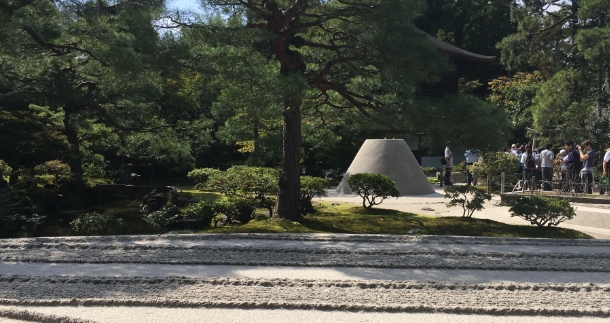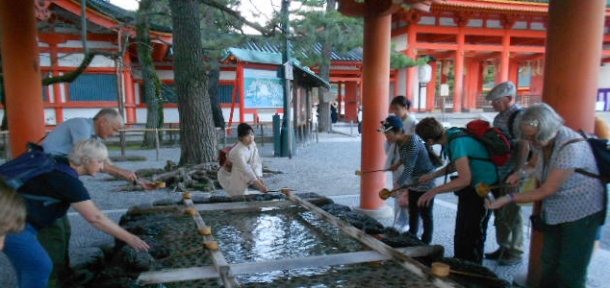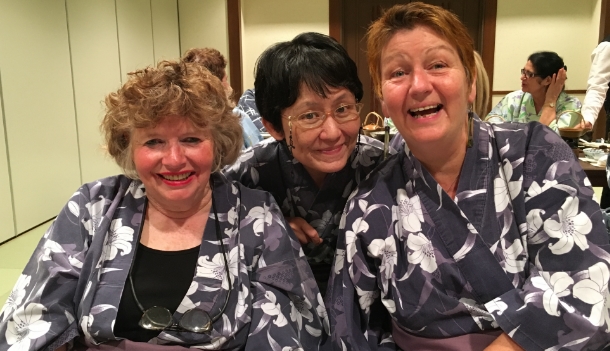Japan – the trip of a lifetime!
Posted:11 November 2016
Its hard to believe that only 3 weeks ago the Garden House explorers and plant hunters set off on the trip of a lifetime to Japan. Our adventure took us to places that were wonderful, unforgettable and occasionally weird. Garden House friend Jane tells all:
Kyoto provided us with our first taste of Japan followed by journeys to Nara, Hiroshima and Hakone, and finally several days spent in Tokyo a packed itinerary of visits to stunning temples, shrines, gardens and palaces interspersed with many great meals and fun experiences.
 Our travels began with a visit to the Ryoan-ji (Dragon+Peace) Temple in Kyoto, famous for its Zen garden of raked gravel with fifteen rocks placed such that it is impossible to see all of them from any single point unless you have reached enlightenment. Here we saw beautiful water gardens and woods carpeted in moss; fascinating to see how the Japanese revere and preserve their old trees using wooden props, the gardeners raking and cleaning and occasionally popping out through the treetops while they pruned.
Our travels began with a visit to the Ryoan-ji (Dragon+Peace) Temple in Kyoto, famous for its Zen garden of raked gravel with fifteen rocks placed such that it is impossible to see all of them from any single point unless you have reached enlightenment. Here we saw beautiful water gardens and woods carpeted in moss; fascinating to see how the Japanese revere and preserve their old trees using wooden props, the gardeners raking and cleaning and occasionally popping out through the treetops while they pruned.
Kinkaku-ji, the golden temple, sits at and over the edge of a lake (a point between heaven and earth) its reflection shimmering across the water. Following the path of the garden, which was designed for strolling and meditation, an ever-changing vista of rocks, moss, pine trees and waterfalls. Here we learnt that if a carp succeeds in leaping to the top of a waterfall it will turn into a dragon.
At Nijo Castle, a monument to the power of the shogun warlords who ruled Japan for many centuries, we learnt that property is measured in Tatami Mats (TMs) Nijo Castle is 800 TMs in size, while the average house at the time was only 6 TMs! The palace buildings are connected by corridors with ‘nightingale floors’ metal nails under the boards rub against a metal clip causing the floors to squeak when stepped on providing an effective alarm system. Screens painted by the greatest artists of the time are designed to impress pine tree images for strength and longevity, ferocious animals and birds of prey and beautiful cherry blossom.
 Some also visited Ginkaku-ji, the silver pavilion on the outskirts of Kyoto. Here there was an immediate impact of the beauty of the gardens, with a view across a large platform of raked white sand and sand cone to the moss gardens beyond. The path took us through a series of small ponds with islands and bridges, and up to a small hill providing vantage points looking down on the garden, through the treetops starting to take on their autumn colour, and across the city of Kyoto to the mountains in the distance.
Some also visited Ginkaku-ji, the silver pavilion on the outskirts of Kyoto. Here there was an immediate impact of the beauty of the gardens, with a view across a large platform of raked white sand and sand cone to the moss gardens beyond. The path took us through a series of small ponds with islands and bridges, and up to a small hill providing vantage points looking down on the garden, through the treetops starting to take on their autumn colour, and across the city of Kyoto to the mountains in the distance.
 At many of the shrines we were invited to purify ourselves at fountains using bamboo cups and water according to a strict ritual, or to buy a ‘fortune paper’ which, if not auspicious, was to be tied to a frame with many others for the wind to carry away.
At many of the shrines we were invited to purify ourselves at fountains using bamboo cups and water according to a strict ritual, or to buy a ‘fortune paper’ which, if not auspicious, was to be tied to a frame with many others for the wind to carry away.
We reached Nara, once the capital of Japan, by roads bordered with golden rod and grasses and, once in the city, roads overrun with wandering deer. Here the Kasuga-Taisha Shrine, and its 3,000 stone and bronze lanterns donated by worshippers, and the Todai-jii shrine, the world’s largest wooden building and housing the oldest gilded bronze Buddha which stands 15m tall.
 Sarah, Caroline, Pat, Chris and Debs!
Sarah, Caroline, Pat, Chris and Debs!
Various experiences along the way provided insight into Japanese culture an intricate Tea Ceremony and a hugely enjoyable Sushi class. Who knew that when making sticky rice you needed a couple of men to wave paper fans furiously over it to cool it down? Sticky rice, seaweed, crab sticks and cucumber were used to construct our sushi I think it is fair to say that we were all thrilled with our efforts! Our very last day in Japan included an Ikebana teach-in, at which we learnt that the skill is in the art of subtraction, less is more in Ikebana, contemplating the negative space and filling it with your rich imagination. Producing our own arrangements was challenging but fun and the show and tell at the end was enlightening!
Our many dining experiences while in Japan ranged from simple in nature and generous in spirit (such as lunch at the Kito Café, run by Kayoko one of Bridge’s former lodgers!) – to dinner at Tempura Matsu, a gastronomic delight with seemingly endless courses of strangely exotic delicacies.
 One of our more exhilarating adventures saw the group travelling down the River Hozugawa in the Arishiyama (Arishi=storm, Yama=mountain) region west of Kyoto in wooden, open top boats, propelled by a team of three men using long oars and bamboo poles. At times the journey was smooth and gentle allowing us to enjoy the ravine and tree-covered mountains and at others exciting as we negotiated the rapids!
One of our more exhilarating adventures saw the group travelling down the River Hozugawa in the Arishiyama (Arishi=storm, Yama=mountain) region west of Kyoto in wooden, open top boats, propelled by a team of three men using long oars and bamboo poles. At times the journey was smooth and gentle allowing us to enjoy the ravine and tree-covered mountains and at others exciting as we negotiated the rapids!
 Once we had our land legs back we walked to the 700 year old Tenryu-ji (Heavenly Dragon) Temple, and from there into the famous Arishiyama Bamboo Grove a dense forest of bamboos where despite the crowds it was possible to stand and absorb the atmosphere wondering at the ethereal light and looking upwards to see the bamboo reaching for the sky.
Once we had our land legs back we walked to the 700 year old Tenryu-ji (Heavenly Dragon) Temple, and from there into the famous Arishiyama Bamboo Grove a dense forest of bamboos where despite the crowds it was possible to stand and absorb the atmosphere wondering at the ethereal light and looking upwards to see the bamboo reaching for the sky.
 Walking around the Gion District gave a wonderful sense of old Kyoto. The city’s most famous geisha district is lined with tea houses and old wooden merchant houses – and with young couples dressed in geisha costume taking selfies!
Walking around the Gion District gave a wonderful sense of old Kyoto. The city’s most famous geisha district is lined with tea houses and old wooden merchant houses – and with young couples dressed in geisha costume taking selfies!
 A visit to the house of the potter Kawai Kanjiro, whose pottery was famous for being both beautiful and practical, was a treat. Kanjiro was a lifelong companion of Bernard Leach and part of the Folk Art Movement that sought to focus on traditional crafts previously cast aside by the industrial revolution. He built his house in traditional Japanese style and it has been converted into a fitting memorial to his life and talent providing a window into how he lived and worked.
A visit to the house of the potter Kawai Kanjiro, whose pottery was famous for being both beautiful and practical, was a treat. Kanjiro was a lifelong companion of Bernard Leach and part of the Folk Art Movement that sought to focus on traditional crafts previously cast aside by the industrial revolution. He built his house in traditional Japanese style and it has been converted into a fitting memorial to his life and talent providing a window into how he lived and worked.
 After a week of hot, sunny weather our view of Hiroshima was through pouring rain, which somehow fitted the mood. We first visited Shukkeien (shrunken scenery) Garden, to which victims of the atomic bomb had fled but which was itself extensively damaged by fire but now restored. Then to the Peace Museum, a stark and harrowing experience; it included many artefacts recovered from the ruins, each one telling a personal story a childs tricycle, a charred lunch, burned school uniform, a watch stopped at 8:15 (the time at which the bomb fell) and videos of survivors talking about their experiences.
After a week of hot, sunny weather our view of Hiroshima was through pouring rain, which somehow fitted the mood. We first visited Shukkeien (shrunken scenery) Garden, to which victims of the atomic bomb had fled but which was itself extensively damaged by fire but now restored. Then to the Peace Museum, a stark and harrowing experience; it included many artefacts recovered from the ruins, each one telling a personal story a childs tricycle, a charred lunch, burned school uniform, a watch stopped at 8:15 (the time at which the bomb fell) and videos of survivors talking about their experiences.
 Walking through the Peace Park we stopped by the Childrens Peace Memorial which commemorates Sadako Sasaki, a young victim, famous for making one thousand origami cranes, hoping they would help her recover.
Walking through the Peace Park we stopped by the Childrens Peace Memorial which commemorates Sadako Sasaki, a young victim, famous for making one thousand origami cranes, hoping they would help her recover.
Another day, another shrine – this time taking a short ferry ride to Miyajima where the magnificent 12th century Itsukushima Shrine and vermillion-painted Great Torii Gate which at high tide appear to float on the sea. A few minutes further up the mountain was the Buddhist Daisho-in temple, a sprawling set of buildings and statues, including many wearing little crocheted hats (donated by parents whose babies and children have died).
 Bridge, our guide Mikko, and Sharon!
Bridge, our guide Mikko, and Sharon!
Next stop Hakone for some dressing up, and dressing down in fact no dressing at all as on arrival we were each provided with a kimono to wear that evening at our Kaseiki meal. Another amazing food experience in which it was fun trying to identify exactly what we were eating. Plenty of fish, certainly! Here also were hot springs an opportunity to unwind, luxuriate, looking up to the blue sky and listening to a waterfall.
The final leg of our journey towards Tokyo took us to the Hakone Open-Air Museum, which was a revelation. Who knew that on the side of a volcanic mountain in Japan you could enjoy world class sculpture and art, including an exhibition hall devoted to Picasso and one of the world’s largest collections of Henry Moore?
Our arrival in Tokyo signalled a change in pace. Our hotel was in Shinjuku, near the busiest train station in the world (3.6 million people a day), and where they employ students during rush hour to push people on and pull people off the trains!
 In the midst of this busy and modern city is the Meiji shrine, set amidst a forest of 100,000 trees donated and planted by volunteers in 1920 in memory of Emperor Meiji, who was responsible for introducing western ways to Japan such as sleeping on a bed, sitting at a table to eat and drinking red wine. Also the Imperial Palace Plaza where the view across the lawns, covered with carefully pruned black pine trees against the backdrop of high rise buildings was equally beautiful in its own way.
In the midst of this busy and modern city is the Meiji shrine, set amidst a forest of 100,000 trees donated and planted by volunteers in 1920 in memory of Emperor Meiji, who was responsible for introducing western ways to Japan such as sleeping on a bed, sitting at a table to eat and drinking red wine. Also the Imperial Palace Plaza where the view across the lawns, covered with carefully pruned black pine trees against the backdrop of high rise buildings was equally beautiful in its own way.
Our last temple visit was to the magnificent Sensoji temple, the oldest in Tokyo although some of the buildings were reconstructed after being destroyed in the war. We were just too early for the November Chrysanthemum festivals but we did see an amazing chrysanthemum tree, a single plant with over 500 flower heads trained in the shape of a tree.
Nearby the Nakamise and Kappabashi shopping streets provided an opportunity to buy souvenirs and kitchen wares – pots, pans, knives, brushes, and more. Plastic food was in abundance, some of which was extraordinarily realistic but with a price tag to match.
 In contrast no shopping trip to Tokyo would be complete without visiting Ginza, the most expensive district in Tokyo. Nobody engaged in ‘explosive shopping’ – a phrase created to describe the shopping frenzies of the Chinese, however many of us were to be found in Kyukyodo buying up beautiful washi papers, brushes and stationery.
In contrast no shopping trip to Tokyo would be complete without visiting Ginza, the most expensive district in Tokyo. Nobody engaged in ‘explosive shopping’ – a phrase created to describe the shopping frenzies of the Chinese, however many of us were to be found in Kyukyodo buying up beautiful washi papers, brushes and stationery.
 We enjoyed a final evening meal together sharing an Izekabyan Meal (peculiarly located on the 45th floor of a nearby office building). Mami, another of Bridge’s former lodgers had arranged a lovely evening that involved more sharing of food and an interlude when everyone was taught to make origami cranes, with varying degrees of success!
We enjoyed a final evening meal together sharing an Izekabyan Meal (peculiarly located on the 45th floor of a nearby office building). Mami, another of Bridge’s former lodgers had arranged a lovely evening that involved more sharing of food and an interlude when everyone was taught to make origami cranes, with varying degrees of success!
 Finally en route to the airport, a visit to the garden of Bonsai master Kumio Kobayashi, a small garden boasting hundreds of bonsai including cypress, prunus and acers, and where pride of place is given to a 1,000 year old pine tree. It was a delightfully Zen moment to prepare us for the long flight home.
Finally en route to the airport, a visit to the garden of Bonsai master Kumio Kobayashi, a small garden boasting hundreds of bonsai including cypress, prunus and acers, and where pride of place is given to a 1,000 year old pine tree. It was a delightfully Zen moment to prepare us for the long flight home.
Such a fascinating country and a fabulous introduction to a country that I’m sure many of us would like to explore more. So watch this space for details of the next Japan trip, as Bridge and Debs are already cooking up plans for a repeat visit in 2017!



